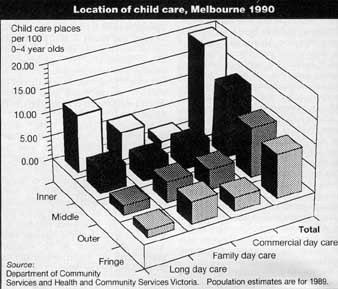Location of child care in Melbourne
You are in an archived section of the AIFS website
November 1990
Abstract
Using statistics gathered for the Australian Institute of Family Studies' Living Standards Study, this article reports on the types of child care available in different suburbs of Melbourne. Ranking the suburbs on the basis of child care relative to the numbers of 0-4 year old children revealed that the fringe suburbs of Melbourne had the least number of places, and the inner suburbs had the most.
The availability and location of child care have been the subject of much public discussion in recent months, with new fee relief provisions, new awards for child care workers, and services for families living on the fringe of Australia's big cities being issues of continuing concern.
This article reports on statistics, gathered for the Institute's Families, Work and Living Standards study, on the types of child care available in different suburbs of Melbourne. It groups local government areas into four 'rings' - eight inner, 22 middle, 14 outer and twelve fringe local government areas. The fringe suburbs are on the edge of the Melbourne Statistical Division - Bulla, Cranbourne, Eltham, Flinders, Hastings, Healesville, Lillydale, Melton, Pakenham, Sherbrooke, Werribee and Whittlesea.
Discussion is confined to the type and amount of child care available, and does not address important related issues such as the quality of child care provided, its cost or suitability for the needs of working parents.
Figures were provided by the Department of Community Services and Health on Long Day Care Places and Family Day Care Places, and by Community Services Victoria on commercial child care places. The places are those approved or registered in early 1990: some commercial child care centres have significant numbers of unfilled places and some outer suburbs are unable, at current wage levels, to attract Family Day Care staff.
Ranking the suburbs on the basis of the supply of child care relative to the numbers of 0-4 year-old children revealed that the fringe suburbs of Lillydale, Hastings, Whittlesea and Pakenham had the least number of places, and the inner suburbs of Fitzroy, Collingwood, Hawthorn and St Kilda the most. As shown in the diagram, when grouped into inner, middle, outer and fringe suburbs, a picture emerges of availability declining with distance from the city. This broadly confirms the data collected by Baker and colleagues who found for example, that 19 per cent of Commonwealth places were in the eight core suburbs but only five per cent of dual-earner young families lived in these areas. (Mary Baker, James Henshall and Margo Hone (1989), Child Care in Victoria and Women's Access to the Labour Force, Working Paper No 22, Department of Labour, Melbourne).
The availability of centre-based child care (government funded or commercial) in outer and fringe suburbs falls well below the standard which has been used by the Department of Family and Community Services (New South Wales) of one centre-based place for each ten children aged up to four years. All areas fall below a standard used by the National Capital Development Commission of one place for each three children (Office of Local Government, Guide to Community Needs Assessment, 1988, Appendix 5).
Commercial child care was unevenly spread, with the high income suburbs of Kew, Malvern, Mornington and Brighton in the top six local government areas. However, Springvale, Oakleigh, Dandenong and Collingwood also have more than five commercial child care places per hundred 0-4 year- olds, so are also well above the metropolitan average.

A second measure, which related the number of places to the numbers of employed families with young children, was used to compare the availability of child care in different areas. Because information was not available on employment of sole parents with young children, this measure takes couples both employed full-time and having a child aged up to four years as the indicator of need.
Whittlesea, Keilor, Broadmeadows and Altona have relatively high proportions of employed families with young children and join Lillydale, Doncaster-Templestowe, Cranbourne and Berwick as local government areas with less than one child care place for each couple with a young child where both parents are employed full-time. At the other end of the scale, Melbourne, Fitzroy, Collingwood and Hawthorn each have more than 2.7 places for each dual-earner young family.
While it can be argued that child care close to the employment opportunities available in the inner city meets the preferences of employed parents to have child care close to their employment, an ABS Child Care Survey, 1987 (Catalogue No.4402.0, Table 7.13) suggests that this is not commonly the case. Among parents of 414,200 pre-school children in formal care, 84 per cent preferred location of formal care close to their home, as against 9 per cent who preferred it close to their own or spouse's work. Just over half of those who had child care close to the workplace wanted a location close to home.
It will be interesting to see whether the new child care fee relief arrangements lead to an expansion of child care in the outer and fringe suburbs, particularly for those who wish their children to attend centre- based care rather than Family Day Care.